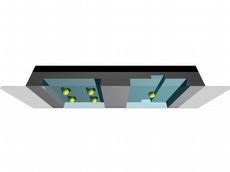Caught in a nano-trap
ETH Zurich scientists have developed a comparatively simple non-contact method to hold nanoparticles at a given location in a liquid for any length of time, thus enabling them to be studied at leisure, something which had previously only been possible using elaborate methods.

Even though invisible to the naked eye, small particles in liquids are in constant motion. The phenomenon is called “Brownian motion” after the botanist Robert Brown. Madhavi Krishnan, Marie Curie Research Fellow at the Laboratory of Physical Chemistry at ETH Zurich, says, “Whenever we want to study the properties of individual ultra-small objects, or their interactions each other in a controlled fashion, we need to overcome Brownian motion.” The ability to hold objects in space is important in biophysics, clinical medicine and the materials sciences – for example to observe molecular processes or for assembling new materials at the nanometre scale.
Electric charge overcomes Brownian motion
Krishnan is the lead author of a study that appeared recently in the scientific journal “Nature”, in which, together with her colleagues, she presents a simple method that enabled them to hold particles ten to a hundred nanometres in diameter at precise locations in a fluid for prolonged periods of time. The scientists did this by constructing a kind of glass sandwich on a nanometre scale into which they introduced tiny gold particles, polymer spheres or fat droplets dissolved in water. One of these glass plates was covered with tiny circular hollows on a scale of about a few hundred nanometres. These tiny depressions create traps that retain single nano-objects.
Krishnan says, “In water, glass surfaces are negatively charged.” Therefore a negatively charged object is strongly repelled by the surrounding glass surfaces. The hollows result in a locally weakened repulsion which is enough to hold the particle freely floating as it were over the hollow for a prolonged period.
The method opens up new opportunities
Up to now it was only possible to trap small particles with elaborate and costly procedures, e.g. optically by using lasers. A commentary on the study in “Nature” says while optical traps permit the object to be moved in space, in contrast to the newly developed method, the major advantage of the current method is that it depends purely on the electric charge and is independent of the mass or size of the object. One possible hurdle however relates to biological objects that usually require solutions with a high salt content. In this case, the force field that is generated by the surfaces and which keeps the object in suspension disappears due to the positively charged salt ions. Nevertheless, based on calculations, the researchers believe that this problem can be overcome by making the distance between the glass plates even smaller.
The commentators in “Nature” stress the attractive possibilities offered by the method developed by Krishnan and her team. Millions of “nano-traps” could be etched into a few square centimetres of glass, opening up new avenues of research in several fields from biophysics to materials science.
Reference:
Krishnan M et al. : Geometry-induced electrostatic trapping of nanometric objects in a fluid, Nature 467 (2010), 692–695, doi:10.1038/nature09404







READER COMMENTS